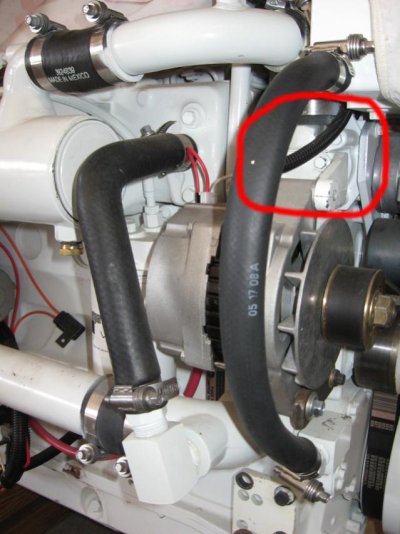- Joined
- Oct 1, 2007
- Messages
- 7,331
- Location
- Texas
- Vessel Name
- Floatsome & Jetsome
- Vessel Make
- Meridian 411
Alright. I have been around engines my entire life. I could always locate a thermostat within seconds. I do know where the coolant goes back into the block from the heat exchanger, but it just appears to be a pip that goes straight into the block....with no housing!!!!!! Now I know that is where it is...that is where it has to be. But in all of my experiences, there has always been an obvious housing associated with a thermostat. I see none here. I am sure it is in there somewhere because it has to seat. But dammit!!! And does it require you to remove the alternator to get to it???
Anyway, in the past, the two easiest things to perform on a boat were the impeller and the thermostat. With a Cummins, that is not the case!!!
I am still chasing a heat issue on the left engine. I have done a bunch of stuff that needed to be down(impeller condition, aftercooler service, radiator flush and replace coolant, and I have even got after the engine with an IR gun to confirm gauge operation). Now before I hire out someone to nip this thing in the bud, I figured that changing the thermostat would be easy(and cheap) enough to check that off the list of offenders. I am not sure how easy it is though. The only thing I have left is the thermostat, oil cooler,heat exchanger, and finally the exhaust elbow...in order of expense.
While I started this thread about thermostat location, I would gladly listen to y'all as it relates to my heat problem. I use the word "heat" instead of overheat. It is not overheating. It has been a steady creep. And now under normal cruise load(2300rpm and 17 knots), It is getting close to 200....every bit of 195). With that said, it has been somewhat random. Sometimes it will not do it. Sometimes it will. I just made a 450 mile journey in early October and it performed perfectly the whole time. But it was still 185ish...188ish. Just hotter than it used to be and definitely hotter than the right side. ANd now even hotter. SO the "randomness" of the occurence could be a symptom of a sticky thermostat. I do know that thermostats generally do NOT cause heating issues...but it is just so easy and cheap to cross off the list.
Next step would be hiring the local Cummins guy to take a boat ride and shoot differential readings along the cooling system.
Also, my boat is severely underpropped(Almost 3100rpm on a 2800rpm engine). So it is not overloaded. The boat has been dove on...and it has been quickhauled...nothing to note. Strainers are clean. No collapsed hoses under load. Water flow APPEARS to be normal....but who knows.
Thanks...I thought this was gonna be a short post...hahaha!!!
Anyway, in the past, the two easiest things to perform on a boat were the impeller and the thermostat. With a Cummins, that is not the case!!!
I am still chasing a heat issue on the left engine. I have done a bunch of stuff that needed to be down(impeller condition, aftercooler service, radiator flush and replace coolant, and I have even got after the engine with an IR gun to confirm gauge operation). Now before I hire out someone to nip this thing in the bud, I figured that changing the thermostat would be easy(and cheap) enough to check that off the list of offenders. I am not sure how easy it is though. The only thing I have left is the thermostat, oil cooler,heat exchanger, and finally the exhaust elbow...in order of expense.
While I started this thread about thermostat location, I would gladly listen to y'all as it relates to my heat problem. I use the word "heat" instead of overheat. It is not overheating. It has been a steady creep. And now under normal cruise load(2300rpm and 17 knots), It is getting close to 200....every bit of 195). With that said, it has been somewhat random. Sometimes it will not do it. Sometimes it will. I just made a 450 mile journey in early October and it performed perfectly the whole time. But it was still 185ish...188ish. Just hotter than it used to be and definitely hotter than the right side. ANd now even hotter. SO the "randomness" of the occurence could be a symptom of a sticky thermostat. I do know that thermostats generally do NOT cause heating issues...but it is just so easy and cheap to cross off the list.
Next step would be hiring the local Cummins guy to take a boat ride and shoot differential readings along the cooling system.
Also, my boat is severely underpropped(Almost 3100rpm on a 2800rpm engine). So it is not overloaded. The boat has been dove on...and it has been quickhauled...nothing to note. Strainers are clean. No collapsed hoses under load. Water flow APPEARS to be normal....but who knows.
Thanks...I thought this was gonna be a short post...hahaha!!!
Last edited:


